
Stolpersteine
Encyclopedia

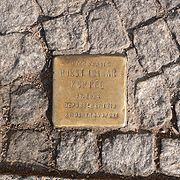
German language
German is a West Germanic language, related to and classified alongside English and Dutch. With an estimated 90 – 98 million native speakers, German is one of the world's major languages and is the most widely-spoken first language in the European Union....
word for "stumbling block", "obstacle", or "something in the way". (The plural form of the word is Stolpersteine.) The artist Gunter Demnig
Gunter Demnig
Gunter Demnig is a German artist. He is best known for his "Stolperstein" memorials to the victims of Nazi persecution and oppression in Nazi Germany.- Biography :...
has given this word a new meaning, that of a small, cobblestone-sized memorial for a single victim of Nazism. These memorials commemorate individuals – both those who died and survivors – who were consigned by the Nazis
Nazism
Nazism, the common short form name of National Socialism was the ideology and practice of the Nazi Party and of Nazi Germany...
to prisons, euthanasia facilities
Action T4
Action T4 was the name used after World War II for Nazi Germany's eugenics-based "euthanasia" program during which physicians killed thousands of people who were "judged incurably sick, by critical medical examination"...
, sterilization clinics
Nazi eugenics
Nazi eugenics were Nazi Germany's racially-based social policies that placed the improvement of the Aryan race through eugenics at the center of their concerns...
, concentration camps
Nazi concentration camps
Nazi Germany maintained concentration camps throughout the territories it controlled. The first Nazi concentration camps set up in Germany were greatly expanded after the Reichstag fire of 1933, and were intended to hold political prisoners and opponents of the regime...
, and extermination camps, as well as those who responded to persecution by emigrating or committing suicide.
While the vast majority of stolpersteine commemorate Jewish
Jews
The Jews , also known as the Jewish people, are a nation and ethnoreligious group originating in the Israelites or Hebrews of the Ancient Near East. The Jewish ethnicity, nationality, and religion are strongly interrelated, as Judaism is the traditional faith of the Jewish nation...
victims of the Holocaust
The Holocaust
The Holocaust , also known as the Shoah , was the genocide of approximately six million European Jews and millions of others during World War II, a programme of systematic state-sponsored murder by Nazi...
, others have been placed for Sinti and Romani people
Porajmos
The Porajmos was the attempt made by Nazi Germany, the Independent State of Croatia, Horthy's Hungary and their allies to exterminate the Romani people of Europe during World War II...
(also called gypsies), homosexuals, Jehovah's Witnesses
Persecution of Jehovah's Witnesses in Nazi Germany
Jehovah's Witnesses were persecuted in Nazi Germany between 1933 and 1945. Members of the religious group refused to serve in the German military or give allegiance to the Nazi government, for which hundreds were executed. An estimated 10,000 were sent to concentration camps where approximately...
, Black people
Rhineland Bastard
Rhineland Bastard was a derogatory term used in Nazi Germany to describe Afro-German children of mixed German and African parentage who were fathered by Africans serving as French colonial troops occupying the Rhineland after World War I...
, Christians (both Protestant
Confessing Church
The Confessing Church was a Protestant schismatic church in Nazi Germany that arose in opposition to government-sponsored efforts to nazify the German Protestant church.-Demographics:...
s and Catholics) opposed to the Nazis, members of the Communist Party and the Resistance
Resistance during World War II
Resistance movements during World War II occurred in every occupied country by a variety of means, ranging from non-cooperation, disinformation and propaganda to hiding crashed pilots and even to outright warfare and the recapturing of towns...
, military deserters
Desertion
In military terminology, desertion is the abandonment of a "duty" or post without permission and is done with the intention of not returning...
, and the physically and mentally disabled.
The list of places that have stolpersteine now extends to several countries and hundreds of cities and towns.
"Here lived"
Schools, relatives, and various organizations research facts about people who were deported or persecuted during the Nazi regime. The database of Yad VashemYad Vashem
Yad Vashem is Israel's official memorial to the Jewish victims of the Holocaust, established in 1953 through the Yad Vashem Law passed by the Knesset, Israel's parliament....
in Jerusalem provides more information.
Once the research is done, Demnig manufactures a concrete cube of 10 cm (4 inches), which he covers with a sheet of brass
Brass
Brass is an alloy of copper and zinc; the proportions of zinc and copper can be varied to create a range of brasses with varying properties.In comparison, bronze is principally an alloy of copper and tin...
. Then he stamps the details of the individual; the name, year of birth and the fate, as well as the dates of deportation and death, if known. The words “Hier wohnte” ("here lived") grace most of the memorials, though others are installed at the individual's place of employment and refer instead to the work. The stolperstein is then laid flush with the pavement or sidewalk in front of the last residence of the victim.
The cost of the stolpersteine is covered by donations, collections, individual citizens, contemporary witnesses, school classes, or communities. One stolperstein costs €95, a price that has remained the same since the project's inception. In 2012, the price will increase to €120.
First stolpersteine
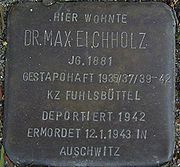
Cologne
Cologne is Germany's fourth-largest city , and is the largest city both in the Germany Federal State of North Rhine-Westphalia and within the Rhine-Ruhr Metropolitan Area, one of the major European metropolitan areas with more than ten million inhabitants.Cologne is located on both sides of the...
. The then priest of the Antoniter church encouraged the project. In 1995, Demnig began to install stolpersteine on trial, without a permit, in Cologne
Cologne
Cologne is Germany's fourth-largest city , and is the largest city both in the Germany Federal State of North Rhine-Westphalia and within the Rhine-Ruhr Metropolitan Area, one of the major European metropolitan areas with more than ten million inhabitants.Cologne is located on both sides of the...
; then in the Kreuzberg
Kreuzberg
Kreuzberg, a part of the combined Friedrichshain-Kreuzberg borough located south of Mitte since 2001, is one of the best-known areas of Berlin...
neighborhood of Berlin
Berlin
Berlin is the capital city of Germany and is one of the 16 states of Germany. With a population of 3.45 million people, Berlin is Germany's largest city. It is the second most populous city proper and the seventh most populous urban area in the European Union...
. In 1996, he set out 55 stolpersteine in Berlin within the scope of the project “Artists Research Auschwitz”. In 1997, he mounted the first two stolpersteine for the Jehovah's Witnesses
Jehovah's Witnesses
Jehovah's Witnesses is a millenarian restorationist Christian denomination with nontrinitarian beliefs distinct from mainstream Christianity. The religion reports worldwide membership of over 7 million adherents involved in evangelism, convention attendance of over 12 million, and annual...
Matthias and Johann Nobis
Johann Nobis
Johann Nobis was an Austrian conscientious objector.-Life:...
in St. Georgen
Sankt Georgen bei Salzburg
Sankt Georgen is a municipality in the district of Salzburg-Umgebung in the state of Salzburg in Austria.-Overview:On July 19, 1997 the artist Gunter Demnig installed two Stolpersteine for Johann Nobis and his brother Matthias Nobis in front of their birth house in Holzhausen at the invitation of ...
, Austria
Austria
Austria , officially the Republic of Austria , is a landlocked country of roughly 8.4 million people in Central Europe. It is bordered by the Czech Republic and Germany to the north, Slovakia and Hungary to the east, Slovenia and Italy to the south, and Switzerland and Liechtenstein to the...
on the suggestion of Andreas Maislinger
Andreas Maislinger
Andreas Maislinger is an Austrian historian and founder of the Austrian Holocaust Memorial Service and Braunau Contemporary History Days.- Studying and learning :...
, founder of Arts Initiative KNIE
Arts Initiative KNIE
Arts Initiative KNIE was founded as an initiative for contemporary art in 1995 in Oberndorf bei Salzburg. It is the origin of the stolperstein project in Braunau am Inn District....
and the Austrian Holocaust Memorial Service
Austrian Holocaust Memorial Service
The Austrian Holocaust Memorial Service is an alternative to Austria's compulsory national military service / alternative service founded in 1992. Since 1998 it is part of the Austrian Service Abroad...
. Four years later, he received permission to install 600 more stolpersteine in Cologne
Cologne
Cologne is Germany's fourth-largest city , and is the largest city both in the Germany Federal State of North Rhine-Westphalia and within the Rhine-Ruhr Metropolitan Area, one of the major European metropolitan areas with more than ten million inhabitants.Cologne is located on both sides of the...
.
Germany
There are thousands of stolperstein memorials located in cities and towns in Germany. Below are just a few of the hundreds of localities, including some of the cities with thousands of memorials each. A more complete list can be found on the list of cities that have stolpersteine.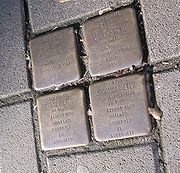
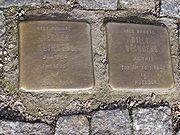
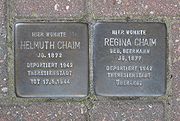
Bamberg
Bamberg is a city in Bavaria, Germany. It is located in Upper Franconia on the river Regnitz, close to its confluence with the river Main. Bamberg is one of the few cities in Germany that was not destroyed by World War II bombings because of a nearby Artillery Factory that prevented planes from...
: on Franz-Ludwig-Strasse, almost half of the homes are marked by stolpersteine.
Berlin
Berlin
Berlin is the capital city of Germany and is one of the 16 states of Germany. With a population of 3.45 million people, Berlin is Germany's largest city. It is the second most populous city proper and the seventh most populous urban area in the European Union...
: there are about 2,950 stolpersteine.
Bonn
Bonn
Bonn is the 19th largest city in Germany. Located in the Cologne/Bonn Region, about 25 kilometres south of Cologne on the river Rhine in the State of North Rhine-Westphalia, it was the capital of West Germany from 1949 to 1990 and the official seat of government of united Germany from 1990 to 1999....
: there are over 100 stolpersteine in the center of town and other quarters.
Cologne
Cologne
Cologne is Germany's fourth-largest city , and is the largest city both in the Germany Federal State of North Rhine-Westphalia and within the Rhine-Ruhr Metropolitan Area, one of the major European metropolitan areas with more than ten million inhabitants.Cologne is located on both sides of the...
: by the beginning of 2005, 1,400 stolpersteine had been placed.
Essen
Essen
- Origin of the name :In German-speaking countries, the name of the city Essen often causes confusion as to its origins, because it is commonly known as the German infinitive of the verb for the act of eating, and/or the German noun for food. Although scholars still dispute the interpretation of...
: over 170 stolpersteine have been placed in more than 20 quarters since 2004.
Frankfurt am Main
Frankfurt
Frankfurt am Main , commonly known simply as Frankfurt, is the largest city in the German state of Hesse and the fifth-largest city in Germany, with a 2010 population of 688,249. The urban area had an estimated population of 2,300,000 in 2010...
: more than 200 stolpersteine have been placed in 15 quarters with the assistance of the Jewish Museum
Jewish Museum Frankfurt
The Jewish Museum of the City of Frankfurt am Main covers the history and culture of the Jewish communities in Frankfurt from the 12th to the 20th centuries. There is another branch of the museum, the Museum Judengasse, in a different part of town....
. Over 12,000 Jews were deported and murdered by the Nazis.
Freiburg im Breisgau
Freiburg
Freiburg im Breisgau is a city in Baden-Württemberg, Germany. In the extreme south-west of the country, it straddles the Dreisam river, at the foot of the Schlossberg. Historically, the city has acted as the hub of the Breisgau region on the western edge of the Black Forest in the Upper Rhine Plain...
: since 2002, about 270 stolpersteine have been installed with the help of civil rights organizations in close partnership with the municipality.
Hamburg
Hamburg
-History:The first historic name for the city was, according to Claudius Ptolemy's reports, Treva.But the city takes its modern name, Hamburg, from the first permanent building on the site, a castle whose construction was ordered by the Emperor Charlemagne in AD 808...
: as of April 15, 2009, there are 2,600 stolpersteine. There’s another stolperstein in memoriam of a former senator, 15 paces to the right of the entrance of Hamburg’s town hall. Many papers report about the project and expand the research. Between 1941 and 1945 10,000 Jews were deported from Hamburg.
Karlsruhe
Karlsruhe
The City of Karlsruhe is a city in the southwest of Germany, in the state of Baden-Württemberg, located near the French-German border.Karlsruhe was founded in 1715 as Karlsruhe Palace, when Germany was a series of principalities and city states...
: more than 140 stolpersteine have been placed, the first on March 18, 2005.
Konstanz
Konstanz
Konstanz is a university city with approximately 80,000 inhabitants located at the western end of Lake Constance in the south-west corner of Germany, bordering Switzerland. The city houses the University of Konstanz.-Location:...
: the first three stolpersteine were placed in September 2006. One was for a Jewish deportee, one for a euthanasia victim and one for a political victim.
Magdeburg
Magdeburg
Magdeburg , is the largest city and the capital city of the Bundesland of Saxony-Anhalt, Germany. Magdeburg is situated on the Elbe River and was one of the most important medieval cities of Europe....
: the first 13 stolpersteine were installed on March 13, 2007. There are more than 70 all over the city.
Neuruppin
Neuruppin
Neuruppin is a town in Brandenburg, Germany. Located on the shore of Ruppiner See , it is the capital of the district of Ostprignitz-Ruppin. Population: 32,800 .-Overview:...
there are 10 stolpersteine for Jews and 6 stolpersteine for "euthanasia" victims from the area; about 1000 victims locally were exterminated under T4.
Stuttgart
Stuttgart
Stuttgart is the capital of the state of Baden-Württemberg in southern Germany. The sixth-largest city in Germany, Stuttgart has a population of 600,038 while the metropolitan area has a population of 5.3 million ....
: there are over 500 stolpersteine in the city and outlying suburbs.
Überlingen
Überlingen
Überlingen is a city on the northern shore of Lake Constance . After the city of Friedrichshafen, it is the second largest city in the Bodenseekreis , and a central point for the outlying communities...
: there are three stolpersteine, placed in front of the District Administration office, based on a book about a persecuted family.
Quakenbrück
Quakenbrück
Quakenbrück is a town in the district of Osnabrück, in Lower Saxony, Germany. It is situated on the river Hase. It is part of the Samtgemeinde of Artland....
: Stolpersteine were recently placed on the site of the synagogue that was burnt down on the 10th November 1938. The background of some of those people whose names they commemorate can be seen and heard in the oscar winning documentary "Into the Arms of Strangers"
Austria
Braunau am InnBraunau am Inn
Braunau am Inn is a town in the Innviertel region of Upper Austria , the north-western state of Austria. It lies about 90 km west of Linz and about 60 km north of Salzburg, on the border with the German state of Bavaria. The population in 2001 was 16,372...
: stolpersteine were laid on August 11, 2006 in Braunau (the city of Adolf Hitler
Adolf Hitler
Adolf Hitler was an Austrian-born German politician and the leader of the National Socialist German Workers Party , commonly referred to as the Nazi Party). He was Chancellor of Germany from 1933 to 1945, and head of state from 1934 to 1945...
's birth) in Upper Austria
Upper Austria
Upper Austria is one of the nine states or Bundesländer of Austria. Its capital is Linz. Upper Austria borders on Germany and the Czech Republic, as well as on the other Austrian states of Lower Austria, Styria, and Salzburg...
and in District 11.
Mödling
Mödling
Mödling is the capital of the Austrian district of the same name located approximately 14 km south of Vienna.The settlement dates back to the Neolithic. In medieval times, the town was the residence of a branch of the Babenberger family, as a result of which it received the nickname...
(near Vienna): 22 stolpersteine have been laid since August 2006.
Salzburg
Salzburg
-Population development:In 1935, the population significantly increased when Salzburg absorbed adjacent municipalities. After World War II, numerous refugees found a new home in the city. New residential space was created for American soldiers of the postwar Occupation, and could be used for...
: three stolpersteine were installed in August 2007.
St. Georgen, Austria (near Salzburg): by 1997, two stolpersteine were installed for Jehovah's Witnesses, but were later destroyed. Two planned additional stolpersteine were cancelled after critics complained. The two destroyed were replaced in 2006.
Vienna
Vienna
Vienna is the capital and largest city of the Republic of Austria and one of the nine states of Austria. Vienna is Austria's primary city, with a population of about 1.723 million , and is by far the largest city in Austria, as well as its cultural, economic, and political centre...
: Demnig’s idea has been further developed since 2005. Stolpersteine have been laid in the second district (Leopoldstadt
Leopoldstadt
Leopoldstadt is the 2nd municipal District of Vienna . There are inhabitants over . It is situated in the heart of the city and, together with Brigittenau , forms a large island surrounded by the Danube Canal and, to the north, the Danube. It is named after Leopold I, Holy Roman Emperor...
) around Volkertplatz. In addition, a "memorial path" is being planned for the second discrict.
Czech Republic
There are stolpersteine in PraguePrague
Prague is the capital and largest city of the Czech Republic. Situated in the north-west of the country on the Vltava river, the city is home to about 1.3 million people, while its metropolitan area is estimated to have a population of over 2.3 million...
, Kolín
Kolín
Kolín is a town in the Central Bohemian Region of the Czech Republic some east from Prague, lying on the Elbe river.-History:Kolín was founded by king Přemysl Otakar II in the 13th century, first mentioned in 1261. Later on, 1437, a castle was founded here...
, Brno
Brno
Brno by population and area is the second largest city in the Czech Republic, the largest Moravian city, and the historical capital city of the Margraviate of Moravia. Brno is the administrative centre of the South Moravian Region where it forms a separate district Brno-City District...
, Neratovice
Neratovice
Neratovice is a town in the Central Bohemian Region of the Czech Republic. It has cca 16,400 inhabitants. The Spolana chemical plant resides there. The town is part of the Prague metropolitan area....
, Teplice
Teplice
Teplice , Teplice-Šanov until 1948 is a town in the Czech Republic, the capital of the Teplice District in the Ústí nad Labem Region. It is the state's second largest spa town ....
, Třeboň
Trebon
Třeboň is a historical town in South Bohemian Region of Czech Republic. The population stands at 8,862 .-History:Třeboň was established around the middle of the 12th century. In 1366 the House of Rožmberk become owner of the estate...
, Olomouc
Olomouc
Olomouc is a city in Moravia, in the east of the Czech Republic. The city is located on the Morava river and is the ecclesiastical metropolis and historical capital city of Moravia. Nowadays, it is an administrative centre of the Olomouc Region and sixth largest city in the Czech Republic...
and Ostrava
Ostrava
Ostrava is the third largest city in the Czech Republic and the second largest urban agglomeration after Prague. Located close to the Polish border, it is also the administrative center of the Moravian-Silesian Region and of the Municipality with Extended Competence. Ostrava was candidate for the...
.
Hungary
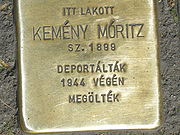
Budapest
Budapest is the capital of Hungary. As the largest city of Hungary, it is the country's principal political, cultural, commercial, industrial, and transportation centre. In 2011, Budapest had 1,733,685 inhabitants, down from its 1989 peak of 2,113,645 due to suburbanization. The Budapest Commuter...
. About 600,000 Hungarian Jews were deported and murdered, primarily at Auschwitz.
Italy
The first 31 stolpersteine were laid in RomeRome
Rome is the capital of Italy and the country's largest and most populated city and comune, with over 2.7 million residents in . The city is located in the central-western portion of the Italian Peninsula, on the Tiber River within the Lazio region of Italy.Rome's history spans two and a half...
in January 2010. The memorials are in eight different locations throughout the city.
The Netherlands
The first Struikelstenen (DutchDutch language
Dutch is a West Germanic language and the native language of the majority of the population of the Netherlands, Belgium, and Suriname, the three member states of the Dutch Language Union. Most speakers live in the European Union, where it is a first language for about 23 million and a second...
for "stolpersteine") were laid in Borne, Overijssel in November 2007. More were installed in other cities in the Netherlands in early 2009 and in April 2010.
20,000th Stolperstein
On July 24, 2009, the 20,000th stolperstein was unveiled in the RotherbaumRotherbaum
Rotherbaum is a quarter of Eimsbüttel, a borough of Hamburg, Germany. In 2006 the population was 16,853.In German, "roter Baum" means red tree. The "th", which in general was abolished in the spelling reform of 1900, was preserved in names...
district of Hamburg
Hamburg
-History:The first historic name for the city was, according to Claudius Ptolemy's reports, Treva.But the city takes its modern name, Hamburg, from the first permanent building on the site, a castle whose construction was ordered by the Emperor Charlemagne in AD 808...
, Germany. In attendance were Gunter Demnig, representatives of the Hamburg government and its Jewish community, and a descendant of the victims memorialized.
As of October 2007, Gunter Demnig had mounted more than 13,000 stolpersteine in more than 280 cities. He expanded his project beyond the borders of Germany to Austria
Austria
Austria , officially the Republic of Austria , is a landlocked country of roughly 8.4 million people in Central Europe. It is bordered by the Czech Republic and Germany to the north, Slovakia and Hungary to the east, Slovenia and Italy to the south, and Switzerland and Liechtenstein to the...
, Italy
Italy
Italy , officially the Italian Republic languages]] under the European Charter for Regional or Minority Languages. In each of these, Italy's official name is as follows:;;;;;;;;), is a unitary parliamentary republic in South-Central Europe. To the north it borders France, Switzerland, Austria and...
, the Netherlands
Netherlands
The Netherlands is a constituent country of the Kingdom of the Netherlands, located mainly in North-West Europe and with several islands in the Caribbean. Mainland Netherlands borders the North Sea to the north and west, Belgium to the south, and Germany to the east, and shares maritime borders...
and Hungary
Hungary
Hungary , officially the Republic of Hungary , is a landlocked country in Central Europe. It is situated in the Carpathian Basin and is bordered by Slovakia to the north, Ukraine and Romania to the east, Serbia and Croatia to the south, Slovenia to the southwest and Austria to the west. The...
. Some stolpersteine were scheduled to be laid in Poland
Poland
Poland , officially the Republic of Poland , is a country in Central Europe bordered by Germany to the west; the Czech Republic and Slovakia to the south; Ukraine, Belarus and Lithuania to the east; and the Baltic Sea and Kaliningrad Oblast, a Russian exclave, to the north...
on September 1, 2006, but permission was withdrawn and the installation was cancelled.
As of May 15, 2010, there were over 22,000 stolpersteine in 530 European cities and towns in eight countries formerly under Nazi control or occupied by Nazi Germany
Nazi Germany
Nazi Germany , also known as the Third Reich , but officially called German Reich from 1933 to 1943 and Greater German Reich from 26 June 1943 onward, is the name commonly used to refer to the state of Germany from 1933 to 1945, when it was a totalitarian dictatorship ruled by...
. By July 8, 2010, there were over 25,000 stolpersteine in 569 cities and towns. As of June 24, 2011, Demnig had installed 30,000 stolpersteine.
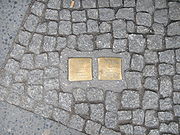
Participation from non-occupied countries
A group of school girls in LondonLondon
London is the capital city of :England and the :United Kingdom, the largest metropolitan area in the United Kingdom, and the largest urban zone in the European Union by most measures. Located on the River Thames, London has been a major settlement for two millennia, its history going back to its...
, England
England
England is a country that is part of the United Kingdom. It shares land borders with Scotland to the north and Wales to the west; the Irish Sea is to the north west, the Celtic Sea to the south west, with the North Sea to the east and the English Channel to the south separating it from continental...
took on a project involving a stolperstein. It memorializes a Jewish victim named Adolf Kahn, who lived in Münster
Münster
Münster is an independent city in North Rhine-Westphalia, Germany. It is located in the northern part of the state and is considered to be the cultural centre of the Westphalia region. It is also capital of the local government region Münsterland...
and died shortly after liberation. His stolperstein was laid on November 25, 2009. Extracts from the school girls' essay were read aloud at the Stolpersteine Exhibition earlier that month. They are the only school group from a country not occupied by the Nazis ever to take on a stolperstein project.
Interest has also come from individuals in America, Israel and elsewhere.
Criticism
Some owners have objected to stolpersteine being laid in front of their houses because of concerns about depreciation and of not wanting to be reminded daily of Nazi atrocities. In one case, in CologneCologne
Cologne is Germany's fourth-largest city , and is the largest city both in the Germany Federal State of North Rhine-Westphalia and within the Rhine-Ruhr Metropolitan Area, one of the major European metropolitan areas with more than ten million inhabitants.Cologne is located on both sides of the...
, a stolperstein was placed away from the entrance at the edge of the sidewalk, near the street. The city of Villingen-Schwenningen
Villingen-Schwenningen
Villingen-Schwenningen is a city in the Schwarzwald-Baar district in southern Baden-Württemberg, Germany. It has 80,941 inhabitants .-History:...
hotly debated the idea of allowing stolpersteine in 2004 and voted against them. The debate, however, has not stopped and has moved into the local press. There is a memorial at the train station and there are plans second memorial.
Munich
Munich
Munich The city's motto is "" . Before 2006, it was "Weltstadt mit Herz" . Its native name, , is derived from the Old High German Munichen, meaning "by the monks' place". The city's name derives from the monks of the Benedictine order who founded the city; hence the monk depicted on the city's coat...
initially rejected stolpersteine but later relented; in other cities, permission for the project was preceded by long, sometimes emotional discussions. In Krefeld
Krefeld
Krefeld , also known as Crefeld until 1929, is a city in North Rhine-Westphalia, Germany. It is located northwest of Düsseldorf, its centre lying just a few kilometres to the west of the River Rhine; the borough of Uerdingen is situated directly on the Rhine...
, an officer from the Jewish synagogue said that Demnig's memorials reminded him of how the Nazis had used Jewish grave stones as slabs for sidewalks. A compromise was reached that a stolperstein could be installed if a prospective site was approved by both house's owner and (if applicable) the victim's relatives. Simbach am Inn
Simbach am Inn
Simbach am Inn is a town on the Inn in the Rottal-Inn district of Bavaria, Germany. The Austrian city Braunau am Inn lies on the opposite side of the river from Simbach.-History:Simbach was one of the first places where electricity was used...
refused to install a stolperstein in memory of Georg Hauner, who was executed on May 1, 1945, because he deserted in the last days of the Second World War. The city of Pulheim
Pulheim
Pulheim is a city in the Rhein-Erft-Kreis, North Rhine-Westphalia, Germany.Since the 1920s, a large substation of the RWE has been sited at Pulheim...
is still debating the issue.
In contrast, Berlin has three full-time municipal employees who support volunteers with the project and are contacts for family members who want to attend an installation.
Reactions of passers-by
People’s attention is drawn towards the stolpersteine by reports in newspapers and their personal experience. Their thoughts are directed towards the victims. Cambridge historian, Joseph Pearson, argues that "It is not what is written [on the stolpersteine] which intrigues, because the inscription is insufficient to conjure a person. It is the emptiness, void, lack of information, the maw of the forgotten, which gives the monuments their power and lifts them from the banality of a statistic."Sources
- Kurt Walter & AG Spurensuche, Stolpersteine in Duisburg, Evangelischer Kirchenkreis Duisburg/ Evangelisches Familienbildungswerk, Duisburg (2005) ISBN 3-00017-730-2
- Marlis Meckel, Den Opfern ihre Namen zurückgeben. Stolpersteine in Freiburg, Rombach Verlag, Freiburg (2006) ISBN 3-79305-018-1
- Beate Meyer (editor), Die Verfolgung und Ermordung der Hamburger Juden 1933-1945. Geschichte, Zeugnis, Erinnerung, Landeszentrale für Politische Bildung, Hamburg (2006)
- Kirsten Serup-Bilfeldt, Stolpersteine. Vergessene Namen, verwehte Spuren. Wegweiser zu Kölner Schicksalen in der NS-Zeit, Kiepenheuer & Witsch (2003) ISBN 3-46203-535-5
- Oswald Burger and Hansjörg Straub, Die Levingers. Eine Familie in Überlingen, Eggingen (2002) ISBN 3-86142-117-8
External links
- The Stumbling Blocks
- Gunter Demnig and the Stumbling Blocks Gunter Demnig’s homepage A report of the Goethe institute Stolperstein article at Shoa
Stolpersteine in Germany
- Stolpersteine in Bad Kissingen
- Stolpersteine in Berlin
- Stolpersteine in Bonn
- Stolpersteine in Berlin - Fürst Donnersmarck-Stiftung
- Stolpersteine in Berlin
- Stolpersteine in Bocholt
- Stolpersteine in Bochum
- Stolpersteine in Cologne
- Stolpersteine in Dresden
- Stolpersteine in Essen
- Stolpersteine in Frankfurt/Oder and Slubice
- Stolpersteine in Freiburg
- Stolpersteine in Gelsenkirchen
- Stolpersteinverlegung in Hamburg/photos
- Stolpersteine in districts of Hamburg
- Stolpersteine in Hamburg Harburg
- Stolpersteine for homosexual victims in Hamburg
- Stolpersteine in Karlsruhe
- Stolpersteine in Konstanz
- Stolpersteine in Leipzig
- Stolpersteine in Magdeburg
- Stolpersteine in Münster
- Stolpersteine in Neuruppin
- Stolpersteine in Bad Hersfeld
- Stolpersteine in Stuttgart
- Stolpersteine in Würzburg
Stolpersteine in Austria
Stolpersteine in the district of Braunau am Inn http://www.moedling.at/stolpersteinereconciliation in the municipality of MödlingMödling
Mödling is the capital of the Austrian district of the same name located approximately 14 km south of Vienna.The settlement dates back to the Neolithic. In medieval times, the town was the residence of a branch of the Babenberger family, as a result of which it received the nickname...
] stones of commemoration in Vienna

